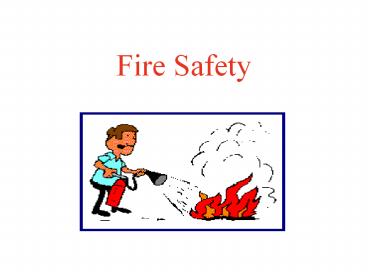Fire Safety - PowerPoint PPT Presentation
1 / 23
Title: Fire Safety
1
Fire Safety
2
- The Fire Triangle identifies the three
components of any fire - Fuel paper, wood, flammable gas, energized
electrical equipment, etc... - Energy (heat), sufficient to support combustion.
Often referred to as the ignition source. - Oxidizer (air)
- IF ANY ONE OF THESE IS MISSING, A FIRE CANNOT
CONTINUE. - THEREFORE
3
- Prevention is based on eliminating or minimizing
one of the components of the Fire Triangle.
4
Prevention
- Other fire prevention methods include
- Heat and/or smoke detectors.
- Automatic fire sprinkler systems.
- Kitchen hood systems.
- Building codes and materials.
- Flame retardant furnishings and materials.
5
Evacuation
- Primary and secondary evacuation routes should be
established, and all employees should be drilled
to use either route. - Exits should be clearly marked and all signs lit
and unobstructed.
6
Remember to RACE during a fire
- R escue rescue clients in immediate danger.
- A lert yell out Fire, pull fire alarm, dial
emergency phone number. - C ontain Close all doors and windows.
- E xtinguish/Evacuate Extinguish small fires,
evacuate clients, if appropriate.
7
Types of Fires
- Class A - Wood, paper,cloth, trash
- Class B - Flammable liquids, oil, gas, grease
- Class C - Electrical, energized electrical
equipment - Class D - Combustible metals
8
Different Kinds of Extinguishers
- The 4 most common fire extinguishers
- All Purpose Water
- Carbon Dioxide
- Multi-Purpose Dry Chemical
- Dry Powder
- Each kind of extinguisher has a specific use
9
All Purpose Water
- Use on CLASS A fires
- Pressurized water
- Pressure gauge present
10
Carbon Dioxide
- Use on CLASS B and CLASS C fires
- Hard, plastic nozzle
- No pressure gauge
11
Multi-Purpose Dry Chemical
- Use on CLASS A, CLASS B, and CLASS C fires
- Fine powder under pressure
- Pressure gauge present
12
(No Transcript)
13
P.A.S.S. Method
- Pull the pin
- This will allow you to squeeze the handle in
order to discharge the extinguisher
14
P.A.S.S. Method
- Aim at the base of the fire
- Aiming at the middle will do no good.
- The agent will pass through the flames.
15
P.A.S.S. Method
- Squeeze the handle
- This will release the pressurized extinguishing
agent
16
P.A.S.S. Method
- Sweep side to side
- Cover the entire area that is on fire. Continue
until fire is extinguished. Keep an eye on the
area for - re-lighting.
17
When NOT to Fight a Fire!
- Remember to keep an exit to your back
- Only fight a fire in the incipient stage
18
Most Important Slide
- NEVER fight a fire if any of the following apply
- Dont have the proper extinguisher or equipment
- Fire has spread beyond its point of origin
- Your instincts tell you GET OUT
19
Emergency Procedures
- In the Event of Fire
- Pull nearest alarm station
- Immediately exit the building
- If you hear an alarm
- DO NOT
- assume it is a drill,
- your life may depend on it!
20
Emergency Procedures
- Building Evacuation
- Proceed to nearest exit in an orderly fashion
- Assemble at least 100 feet from building
- Provide emergency crews with information about
people still in the building - Provide information to emergency crews about the
reason for evacuation - Never re-enter a building until instructed to by
the police department, fire department, or EHS
staff.
21
Fire Hazards at Work
Heat generating appliances Storage and handling
of flammables/combustibles Open flames Vehicles
and equipment
22
Heat Generating Equipment
- Coffee pot
- Toaster oven
- Microwave
- Mug warmer
- Heaters
- Cooling fans
- Torch/Heat gun
- Other electrical appliances
- Ensure 36 or more of clearance from other
combustibles - UL listed
- Grounding prongs
- Plug into outlet directly
- Heaters need tip-over protection
- Shut it off!
23
Survive a Fire
- How to Survive a Fire
- Dont get trapped
- Cover your mouth and nose with a damp cloth (when
possible) - Keep low to the floor
- Dont hide
- Be determined to survive
- If clothes catch fire Stop, Drop and Roll
- Once out of the building NEVER RETURN!































